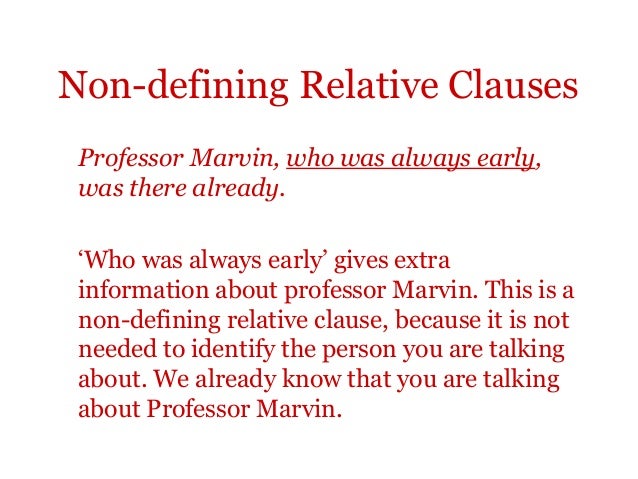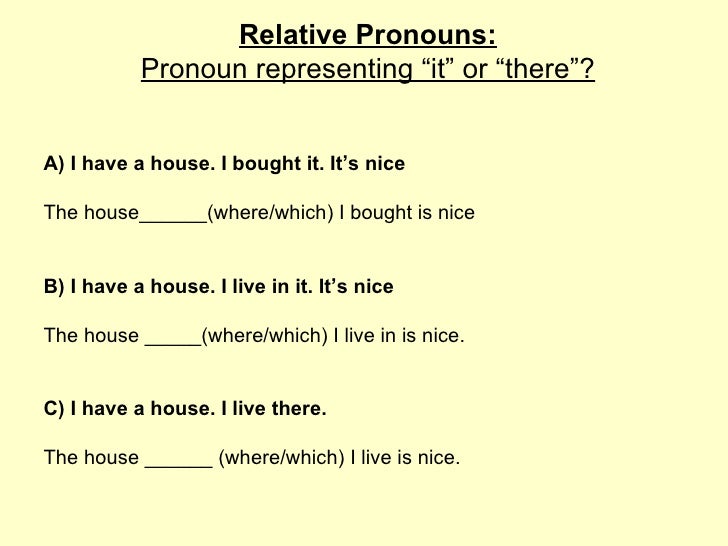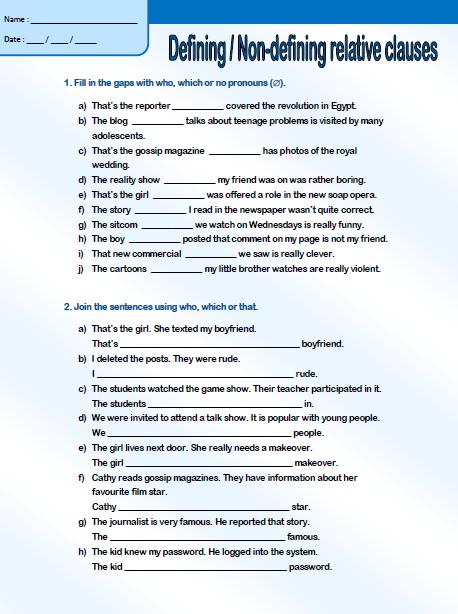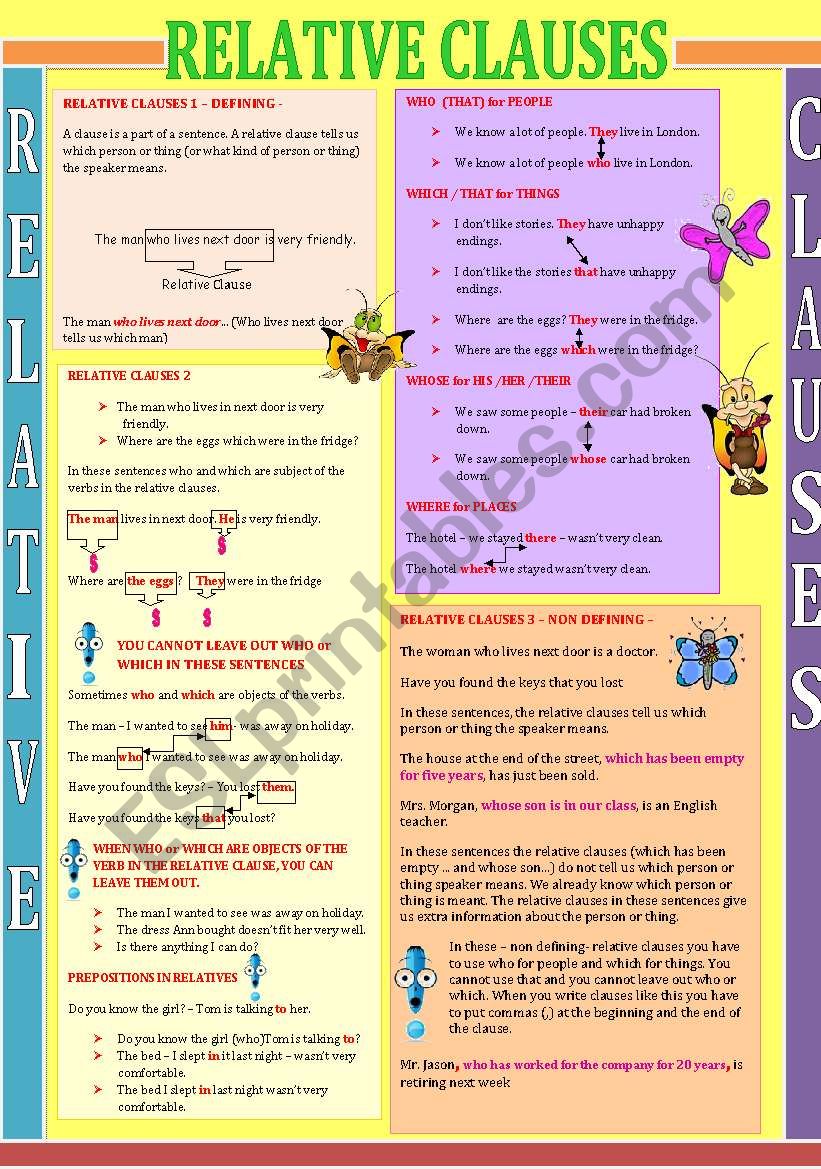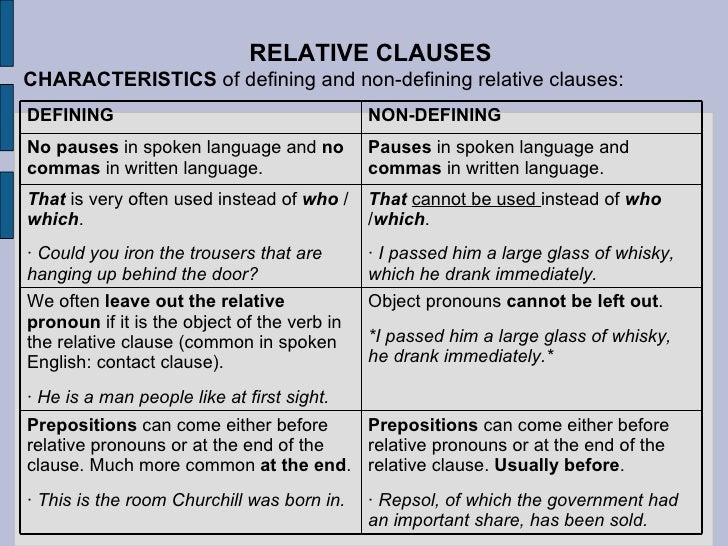Although similar in use, relative pronouns that introduce a non-restrictive relative clauses ARE separated from the main clause by a comma . Typically, which is the preferred relative pronoun for indicating that a relative clause is non-restrictive. Non-restrictive relative clauses (also known as non-defining relative clauses) provide non-essential information about the antecedent in the main clause. The information is not crucial for understanding the sentence's meaning correctly and can be omitted without affecting the sentence's meaning. In other words, non-restrictive relative clauses are an aside that adds extra information.
All relative pronouns EXCEPT that can be used in non-defining clauses; however, the pronouns MAY NOT be omitted. On the other hand, a non-defining relative clause adds an extra, non-essential piece of information to a sentence. In non-defining relative clauses, the relative pronoun or adverb cannot be replaced by "that" and the clause must be separated from the rest of the sentence by commas. Concerning the choice of relative adverbs or pronouns, the relative adverbs "where", "when" and "why" can be used for location, time, and the reason for something happening, respectively. All can be replaced by "that" in defining relative clauses but, as stated above, if "that" (or "which") replaces "where" an extra preposition must be added to the sentence. We use "which" for things and "who" is used for people, and in defining relative clauses "that" is also always possible.
Remember, it is not possible to use "that" in a non-defining relative clause. In defining relative clauses, the pronouns who, whom, and which are often replaced by that in spoken English. In non-defining relative clauses, you cannot replace other pronouns with that. You also cannot leave out the relative pronoun in non-defining relative clauses, in the way you sometimes can in defining relative clauses.
The pronoun is required, even when it is the object of the verb in the relative clause. Finally, non-defining relative clauses are always separated from the rest of the sentence by commas, unlike defining relative clauses, which have no punctuation. It is also possible to present all the grammar through separate sentences. For the first stage students can simply match the vocabulary to the definitions. Alternatively, for more challenge you can split the definitions into two and get them to match the words to two parts and/ or think about which bits go together.
Do Defining Relative Clauses Have Commas They can then analyse the language in those definitions for what relative pronouns are used, etc. This all leaves "that" as the only major difference in pronouns between defining and non-defining relative clauses. However, another difference related to pronouns is that relative pronouns cannot be removed from non-defining relative clauses, unlike in defining relative clauses. For example, "which" is optional in sentences like "This is the time I enjoy most of all" but cannot be taken out of "My only big indulgence is cheese, which I spend more on than anything else".
We can find non-defining relative clauses either after the subject or after the object of the main clause. They are introduced by a relative pronoun followed be the relative clause and, if they identify the subject, the verb of the main clause. They are always separated by commas from the main clause. Nondefining relative clauses provide supplementary information. However, the information is not key to the meaning of the sentence. In fact, the sentence would still make sense if you removed the nondefining clause.
Look at these example sentences with and without nondefining clauses. Relative pronouns that introduce a restrictive relative clause ARE NOT separated from the main clause by a comma. Restrictive relative clauses add essential information about the antecedent in the main clause. The information is crucial for understanding the sentence's meaning correctly and cannot be omitted. In other words, without the restrictive relative clause, the sentence does not make sense.
Non-defining relative clauses are different from defining relative clauses. In the first sentence below, the comma shows us thatwho work very hard is extra information - if we take out this information, the listener will still understand which teachers we are talking about. In the second sentence there is no comma -who work very hardis necessary to the meaning of the sentence because it explains which teachers we are talking about. Non-defining relative clauses need commas around them, while defining relative clauses don't.
Non-defining relative clauses are also less common in informal, spoken English. Reduced relative clauses are especially common in academic English. Non-defining relative clauses provide interesting additional information which is not essential to understanding the meaning of the sentence. We use non-defining relative clauses to give extra information about something - either the previous noun , or all of the previous information .
For more information about words like which and whom, look at the relative pronouns page). In informal communication, relative pronouns, such as who and when,are commonly replaced with that in defining relative clauses. A relative clause is an added part in a sentence that is used in relation to the main sentence.
However, sometimes a relative clause is so important that the main sentence will be difficult to understand or have no meaning without it. On the other hand, we often use a relative clause just to add extra information, which is usually indicated by the use of commas. The meaning of the main sentence will still be clear without it and it is therefore called a non-defining relative clause. By using commas in written English and a slight pause in spoken English, two identical clauses can have different meanings when used in a sentence. A defining relative clause, also called a restrictive or essential clause, carries essential meaning to the rest of the sentence and does not need any commas.
Whereas, a non-defining or nonrestrictive relative clause only contains additional, emphatic information that necessitates comma encapsulation. A restrictive clause restricts or defines the meaning of a noun or noun phrase and provides necessary information about the noun in the sentence. It is not separated from the rest of the sentence by commas. Restrictive clauses are more common in writing than nonrestrictive clauses.
A restrictive clause is also sometimes referred to as an essential clause or phrase. When using defining relative clauses in informal speech and writing, the relative pronoun can be left out completely if it refers to the object of the relative clause. Other relative pronouns ("which", "who", "whose", "preposition + which", and "whom" if you decide to teach it) can be used in exactly the same way in defining and non-defining relative clauses.
Non-defining relative clauses are composed of a relative pronoun, a verb, and optional other elements such as the subject or object of the verb. Commas or parentheses are always used to separate non-defining relative clauses from the rest of the sentence. One of the features of written academic English that gives it its greater complexity is longer sentences, with more frequent use of subordinate clauses. A clause is part of a sentence and a subordinate clause is a group of words with a subject and a verb that cannot stand alone as a sentence. Relative clauses, both defining and non-defining, are a kind of subordinate clause.
Defining ones tell us which thing or person is being referred to, or what kind of thing or person the writer or speaker means. Non-defining ones just add extra, non-essential information about the person or thing being referred to. This Learning Object will provide you with the rules about their use and show you ways that they can sometimes be shortened or replaced by noun phrases to create a more concise style. "whom" is only really used in very formal English. It is more common to use "who" as the object pronoun for people.
In non-defining relative clauses, "who" and "whom" are NEVER replaced by "that". Non-defining relative clauses can use most relative pronouns but they CAN'T use 'that' and the relative pronoun can never be omitted. A non-defining relative clause is usually separated from the rest of the sentence by a comma, which functions in much the same way as a bracket or parenthesis. For example, in the sentence "The mouse, which my mom bought me, is running in the wheel," the clause "which my mom bought me" is separated from the rest of the sentence by commas. This indicates that the information within the commas is not used to provide additional meaning. The non-defining relative clause in this case simply gives more information about the mouse that is the subject of the sentence.
There is another whole article on reduced relative clauses on this site. The same is true about the relative pronoun "why" in "the reason why…", but as this is the only time that "why" is a relative pronoun, I generally don't present it at all. Another important point to understand is that we can use the word 'that' instead of 'who' or 'which' in defining relative clauses but not in non-defining relative clauses. The most important information in this sentence is that Barcelona is beautiful, the fact that I live in Barcelona is just additional information. While both types of relative clauses add extra information to the sentence, a defining relative clause clearly adds detail about a specific noun that is defined.
The following relative pronouns are used in non-defining relative clauses. These relative pronouns appear at the start of the non-defining relative clause and refer to a noun that appears earlier in the sentence. The two main types of relative clauses are defining and non-defining. A defining clause may sometimes be called either a restrictive or essential adjective clause.
A non-defining clause is sometimes called a nonrestrictive or inessential adjective clause. Correct punctuation is essential in non-defining relative clauses. If the non-defining relative clause occurs in the middle of a sentence, a comma is put before the relative pronoun and at the end of the clause.
If the non-defining relative clause occurs at the end of a sentence, a comma is put before the relative pronoun. In defining relative clauses, there are no commas. Non-defining relative clauses do not define the person, thing or animal we are talking about. Non defining relative clauses give extra information about a noun. This information may be interesting or useful, but unlike defining relative clauses, it is not necessary for the meaning of the sentence to be clear. Non-defining relative clauses are more often used in written English than in spoken English.
You can tell that a clause is non-defining because it is separated by commas at each end of the clause. Students fill in "five down", "four across", etc with words and expression that match the definitions which are given. If you give them Student A and Student B versions of a crossword with different answers already completed, the same can also be done orally. Both defining and non-defining relative clauses give extra information about the main clause.
This defining relative clause is, as the name suggests, defining which brother I am talking about. UseNon-defining relative clauses do not help us to identify someone or something. They give additional, interesting information which is notessential to the meaning of the sentence. Non-defining relative clauses add non-essential information to a sentence and can be left out of a sentence without changing it's meaning. A non-defining relative clause is separated from the main part of the sentence by commas. A defining relative clause is not separated from the main part of the sentence by commas.
Non-defining relative clauses are always separated from the rest of the sentence by commas. In both defining and non-defining relative clauses, the object form of "who", which is "whom", is usually only used in formal writing, but it must be used if it directly follows a preposition. The possessive form of "who", which is "whose", is used usually for people. In the following defining relative clauses, put a tick if the relative pronoun ('that', 'who' which' etc.) can be omitted. Remember it is only possible to omit the relative pronoun if it is the object of a defining relative clause.
A nonrestrictive clause adds additional information to a sentence. It is usually a proper noun or a common noun that refers to a unique person, thing, or event. It uses commas to show that the information is additional. The commas almost act like parentheses within the sentence. If the information between the commas is omitted, readers will still understand the overall meaning of the sentence.
A nonrestrictive clause is also known as a nonessential clause or phrase. Relative clauses that don't have commas are called non-defining/non-restrictive; these relative clauses provide additional information and do not identify. Non-defining relative clauses are made in the same way. An important difference, however, between both types of clause is the use of punctuation.
With non-defining relative clauses, we separate the clause with commas. Non-defining relative clauses add extra information to a noun or noun phrase. Non-defining relative clauses are separated from the rest of the sentence by commas.
The purpose of a non-defining relative clause within a sentence is to provide additional information about something within it. This information is not crucial to the sentence, however, and it does not impact the overall purpose in a meaningful way. They are referred to as "non-defining" or "non-identifying" because of this, while other relative clauses can provide this type of information. Non-defining relative clauses, however, arenot essentialto the sentence. If the clause is removed, the sentence still makes sense and has the same meaning.
Paradoxically speaking, the essential information is the one that does not essentialize pre-commas when used in defining relative clauses. At this point, I'm sure it is going to be easier to make sense of non-defining relative clauses, which are also called nonrestrictive or inessential clauses. The reference to the antecedent is already completely known; the which-clause does not add any information which helps to specify what the antecedent refers to. Non-defining relative clauses are like parenthetical remarks. They always use "which", and they are always set off by commas.
In this sentence the relative clause 'who comes from Rome' does not help us to define the noun. The woman only has one husband so we don't have to answer the question 'Which husband? ' We call this a non-defining relative clause because it doesn't define the noun.
Notice that defining relative clauses are not separated from the main clause by commas. Furthermore, we can always use that instead of which or who in defining relative clauses. We use defining relative clauses to give essential information about someone or something — information that we need in order to understand what or who is being referred to.




